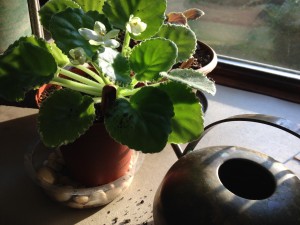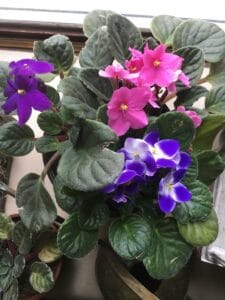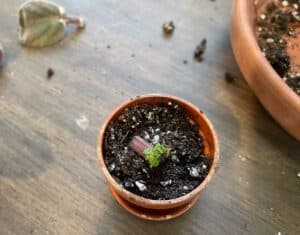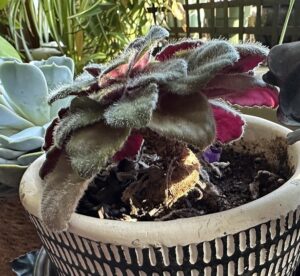Hello, fellow lovers of all things green. During the recent deep freeze and high winds, I brought my podcast from the screened porch inside and recorded it while sitting in front of my indoor plants. I noticed that the low humidity of the house has already caused them stress. The remedy of gathering rain from the gutters or using melted snow to give them a nitrogen boost when I water will help. But the one African Violet I have left is in the worst shape, and a nitrogen boost won’t do the trick. Thankfully, I learned about radical repotting to fix the long stem. So there is hope!

Mom’s ‘Frozen in Time’ African Violet
The sad African Violet led me down memory lane of a story titled Caring for African Violets – Frozen in Time, written in 2015 when Mom was in the nursing home. “You can’t water their faces,” recalls brother Rick, one of Mom’s instructions on caring for African violets, as water on their leaves can cause spotting damage. Mom had quite a collection of violets when we were kids.
African Violets are Popular Houseplants
African Violets are considered easy to grow and bloom prolifically. How delighted I was when one of Mom’s treasures first bloomed. Her dark green leaves have creamy white edges complimented by cream-colored flowers edged with pale green. Her variety is ‘Frozen in Time,’ which is fitting. While all flowers fade, our memories of our loved ones are forever frozen in time.

A dear friend gave me this African Violet Trio.
Over time, my cherished plants failed. Sadly, it seems I don’t have a green thumb for the easy-to-grow. I clicked through the African Violet Society of America’s website and learned you can ask an expert. And so, I wrote:
African Violet Society of America’s – Ask the Expert
Hi there, African Violet Expert. I have only one violet left, a gift from a friend after my dear Mom passed. Emma Stone was a member of your society whose collection of African violets I adopted during her dementia journey. One by one, I lost them.
I’m giggling because a few of the fatalities involved my rescue, Jolee, now about four and a half. Soon after I adopted her, the only plants she messed with were leaf cuttings from Mom’s ‘Frozen in Time,’ which I lovingly rooted in tiny clay pots Mom used to start new plants.
The first time I discovered Jolee’s carnage of throwing the pots to the floor, I thought my 5-month-old street dog from Biloxi was scouting for food, and Mom’s cuttings were within reach. Thankfully, she didn’t eat them, although, according to the ASPCA, they aren’t toxic to dogs or cats. All the leaves and baby roots were intact, so I repotted the treasures.

Jolee’s Carnage of ‘Frozen in Time’ Cuttings

A Face of Innocence
Two days later, Jolee had her way again with the plants to no repair. I laughed until I cried, thinking Mom was part of the scene. I pictured her contagious chuckling augmenting to hilarious, happy tears, too. It was a funny moment. Although I am sad, I lost the plants.
Back to my last violet standing: Over time, I’ve removed the lower leaves as they declined, leaving me with a healthy top part of the plant (somewhat so anyway) but only a stalk for the lower part. I should mention that I am a garden designer and know a few things about plants, but I’m stumped.
I promptly heard back from Joyce Stork.
“Dear Mary, your violet needs to be restarted. What I see in the photo is typical of how African Violets occasionally age when a ‘neck’ develops. Surgery is necessary to rejuvenate the plant and bury the neck.”

African Violet Needing Radical Repotting
She shared a video (How to Repot a Long Neck and Cure Root Rot) that shows the method she’s used successfully thousands of times. I list the surgery steps at the end of the post. The cliff notes version: remove the leaves up to the top healthy center of the plant. Then, cut the stem to about an inch, trim the stem stubs, and plant it in fresh, damp African Violet potting mix. Then, put the plant in a plastic bag, blow air into it, close it with a twist-tie, and place it near a window for one month. After which, open the bag for a day and then remove it, and your Violet should be re-rooted and ready to grow.
“It looks terrifying to many growers. If it scares you, propagate several leaf cuttings out of reach of your beloved pup as insurance before you do the transplanting.”
Joyce suggested using a smaller, four-inch shallow pot. “Typically, African Violets bloom more freely in pots about a third the diameter of the plant. Happy growing!”
Thank you, Joyce. There is hope! And there are the cherished memories of my dear Mom and her love of African Violets frozen in time.
Garden Dilemmas? AskMaryStone@gmail.com and your favorite Podcast App.
And I will add Violet Dilemmas? Ask the African Violet Society of America.
There’s more to the story in the Garden Dilemmas Podcast:
Surgery Steps for Fixing African Violets with Long Stems per the video Joyce shared:
1. Cut the stem (the elongated neck) above the rotted stem.
2. Strip the leaves back to reach the plant’s healthy top. Remove flowers and all of the dead tissue.
3. Cut the stem to about an inch with a clean knife (so you don’t spread the rot). Then, use the knife to trim the stem stubs to smooth them down. You may need to remove a few more leaves or cut the stem a bit shorter to be able to set it square in the pot.
4. To prepare your 4-inch pot, dampen your African Violet Potting Mix (a lighter soil than others) to the texture of pie dough so that it holds together but is not soggy. Then, put the mix into the pot to the rim. Water again with a slow drip so the soil gets heavier but doesn’t drip through the bottom of the pot.
5. Place the crown squarely in the center of the pot. Don’t worry if the leaves are leaning; they will straighten themselves out.
6. Get a plastic bag about the size of the ones you get in the produce section, or use a zip-loc bag. Set the potted plant in the bag and close it with a twist tie (or close the zip-loc) after blowing in it to fill it with air. Adjust the bag the best you can to keep it away from the leaves.
7. If you use grow lights, position the plant on the edge of the lights — not directly under — with the leaning side away from the light so that it straightens out. I don’t use grow lights, so I will position mine so the leaves are bent away from the window.
8. Leave it there for one month, and it will root again. Then, open the bag and leave the plant in it for one day before taking it out and returning it to its home.
Thanks again, Joyce; I have a revived interest in growing African Violets again! My Mom would be proud :^)
Related Post and Podcast you’ll enjoy:
Caring for African Violets – Frozen in Time – Blog Post
Benefits of Watering with Rainwater – Blog Post
Ep 04. Sweet Autumn Clematis, Rainwater Rejuvenation


